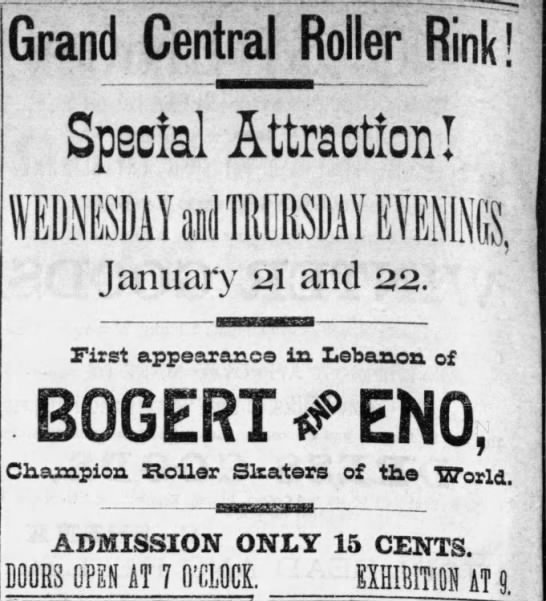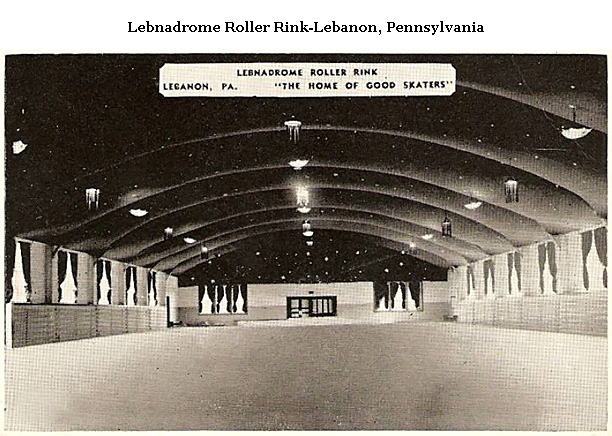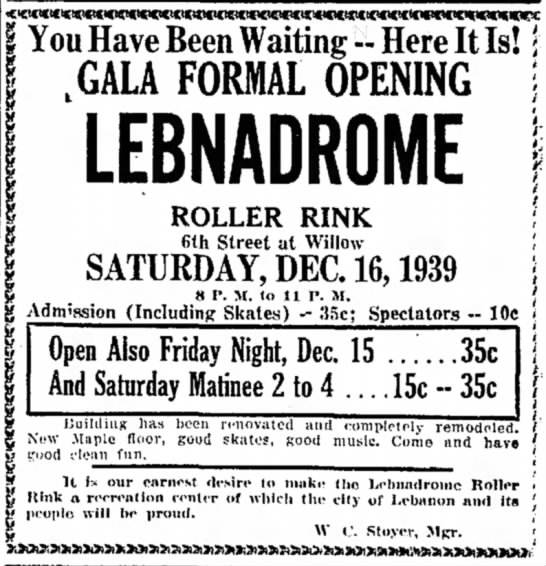The reinvention of roller skates in the mid-1860s precipitated a century of fascination with the sport across the country, and Lebanon County was no exception. Take a trip back into the Golden Age of roller skating and see how Lebanon’s take on the pastime changed through the years.
The Keystone & Grand Central Rinks
There is little information available on these early Lebanon rinks. The Keystone rink was the older of the two, having finished construction in July of 1884 along North 9th Street and above Lehman Street.
According to the Daily News at the time of its construction, rinks were “profitable investments” with “hundreds of thousands of dollars” being put into them. It is unknown exactly how much Kassner and Fisher, the two names cited as constructing the Keystone, spent on the project. The rink’s amenities are also something of a mystery, though it did include an in-house organ.
It was evidently a successful operation, as the “commodious” rink was “nightly filled with pleasure seekers.” In spite of its apparent popularity, the Keystone was sold mere months later in February of 1885 for armory purposes, according to the Harrisburg Daily Independent. The Daily News had reported just weeks earlier that the rumor of its closing was “a canard of the first water.” The building was later converted into a market house.

Much like its contemporary, the Grand Central rink has more or less been lost to time. The construction was finished in January of 1885, only a month before the Keystone would be sold. It was located on North 8th Street, “this side of the railroad” — presumably south of it.
The charm of these old-fashioned rinks cannot be overstated, as the typically florid newspaper coverage of the time demonstrates. A particularly effervescent description of the Grand Central appeared following its first public opening:
“From the music stand[…]delightful strains of music emanated, to which youth and beauty kept time, gracefully skimming over the surface of the floor with hearts light and pleasure unrestrained.”
The Daily News
Lebanon, Pennsylvania
12 Jan 1885
Roller skating celebrities of the period, including “lady skater” Ella Stetson, “young professionals” Bogert and Eno, and a duo known as the Pressy-Lester Star Combination made appearances at these rinks, charging around a quarter for tickets. These regionally-touring stars were very popular attractions and their acts variously involved musical performance, acrobatics, roller skating trick moves, and even the occasional bicycle.
The Grand Central fared somewhat better than its contemporary, with over 2,000 skaters showing up for certain events. The building was leased during the summer months for fairs and markets. While these events went on, the floor was covered in sand to prevent wear-and-tear. By 1887, the rink was no longer considered profitable on its own, and a year later the “old” rink was better known as a market house.
The Grand Central is also notable for its in-house music, the Grand Central Orchestra, a group of brass musicians which survived the closing of their establishment and continued to perform locally for a number of years. These musicians were associated with the Perseverance Band and were considered some of the area’s best.
The Casino Roller Rink

The Lebanon Bathing Casino, an recreational establishment built in 1927 along West Oak Street (then known as Campbelltown Road), was locally known for its swimming pool, and only a year later, it added a roller rink to its attractions.
The auditorium that the rink was housed in was finished in 1928, served as a recreation hall. When built, it had dimensions of 120 feet by 80 feet.

The rink was in operation for decades, hosting Ladies’ Nights, school events, and even an appearance by a roller skating horse named Jimmy in 1953. Its ticket prices were kept low throughout its history, raising to only a few dollars by the end of its existence.
Sadly, the Casino rink burned down in January of 1996, following a snow-induced roof collapse. The collapse damaged internal wires and led to a fire, which caused $356,000 worth of damages to the building and interior.
At the time, a number of calls were made for a new rink to be opened, although the costs of rebuilding were deemed to be too great. But the times spent there were not forgotten by those who loved the pastime. “I met my husband there many years ago,” recalled the author of an anonymous letter published in the Lebanon Daily News.
The Lebnadrome

The Lebnadrome Roller Skating Rink operated for just over a decade in the mid-20th century. Considering the fate of its 1880s predecessors, it is somewhat ironic that the rink was built inside a pre-existing market house on Sixth and Willow Streets. It held its official opening on December 16, 1939.
The new rink boasted 16,000 square feet of space, maple flooring, a Hammond electric organ, and free dance skating lessons. It operated year-round, hosting everything from competitive events, school dances, and Girl’s Nites, to parties celebrating major holidays like Christmas, Thanksgiving, Easter, Halloween, and Valentine’s Day.
There was even at least one turkey hunt held at the rink, in which live turkeys were suspended from the ceiling and the skaters (first boys, then girls) tried to find the birds, skating with paper bags over their heads. The winners got to take the birds for themselves.

This was an era that saw roller skating become a minor sport. In contrast to the late 1800s, when roller skaters dressed up for the night and skating was seen as an elegant act akin to dancing, the rinks of the 1900s had a more competitive spirit, with contests being held for various styles of skating such as the two-step and cups and medals awarded to winners.
In June of 1950, the Young Democrats Club opened up the building that the rink occupied, having turned part of the space into a grill. The Club’s occupation did not last very long, as a fire on March 6, 1952 “completely destroyed” the building, as a Lebanon Daily News report noted at the time. Nobody was seriously injured, but the fire’s million-dollar damages effectively shut down any hopes of a reopened rink.

Mt. Gretna Roller Rink
Any review of Lebanon rinks would be hopelessly incomplete without including the only one still in use today: the Mt. Gretna Roller Rink.
The building that the rink is housed in is actually the oldest building in the town, having been built in 1890 for a regional farm show, the Farmer’s Encampment. Then known as Farmer’s Hall, the annual show left the area in the 1920s. The building, however, was converted into a roller rink around a decade later.
Read More: Before the Pennsylvania Farm Show, there was the Mt. Gretna Farmers’ Encampment

Since then, the rink has been a staple of the town’s attractions. Its beginnings as an exhibition hall made it one of the bigger spaces available to roller skate in the area, and it continues to attract locals for private and birthday parties.
Ray Long, the rink’s longtime organ player, gave an interview to the Lebanon Daily News in 2006, and explained how he got his love for roller skating and the classic Hammond organ sound at the Lebnadrome and Casino rinks in his youth. Long passed away in 2009, after more than four decades playing for patrons of the rink.

Though the rink has seen its share of changes over the years, it remains popular and open for some of that classic good clean roller-skating fun. From September to May, the rink opens in the afternoons on Saturdays and Sundays, according to the hours posted on its website. Family Nights and evening sessions are also available, and skates can be rented from the rink.
Other rinks
A few lesser-known rinks have briefly existed in the county at various points. Information on these is scant:
- A sole reference to a skating rink in Myerstown appeared in the Daily News in August of 1885, announcing a performance by the Richland Band.
- A “short but decisive fight” occurred in an unnamed rink on North Sixth Street in March of 1894.
- It seems that the Lebnadrome’s address is the same as the Weimer Auditorium Palace Roller Rink, an earlier operation also at Sixth and Willow that was open for at least a couple years beginning in October of 1906. Whether these two rinks were exactly the same space is unclear.
- Several references to a “new large skating rink” for rollers in Mt. Gretna were made in 1919, over a decade before the rink familiar to us all opened. Ads from subsequent years indicate that the rink was in the Mt. Gretna park.
Do you enjoy Lebanon County history?
So do we. Our stories are free to read thanks to the support of our members and advertisers. Help us tell more stories of Lebanon County’s past by joining LebTown as a member.
Join LebTown as an annual member and you’ll reserve a mug of your own, plus all the usual benefits!
Learn more and join now here.




































